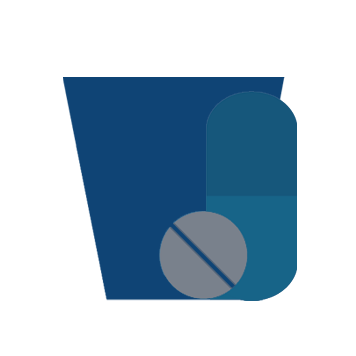Compare drug prices at GoodRx.ca
Common Conditions | Specialty Medications
HIV
HIV (human immunodeficiency virus) is a virus that attacks the body's immune system. If HIV is not treated, it can lead to AIDS (acquired immunodeficiency syndrome). Learning the basics about HIV can keep you healthy and prevent HIV transmission.
HIV infection is caused by the human immunodeficiency virus. You can get HIV from contact with infected blood, semen, or vaginal fluids. Most people get the virus by having unprotected sex with someone who has HIV. Another common way of getting it is by sharing drug needles with someone who is infected with HIV.
Primary infection (Acute HIV)
Some people infected by HIV develop a flu-like illness within two to four weeks after the virus enters the body. This illness, known as primary (acute) HIV infection, may last for a few weeks. Possible signs and symptoms include:
- Fever
- Headache
- Muscle aches and joint pain
- Rash
- Sore throat and painful mouth sores
- Swollen lymph glands, mainly on the neck
- Diarrhea
- Weight loss
- Cough
- Night sweats
These symptoms can be so mild that you might not even notice them. However, the amount of virus in your bloodstream (viral load) is quite high at this time. As a result, the infection spreads more easily during primary infection than during the next stage.
Common treatments include: View
Speak with a Canadian Pharmacist
CANCER
Cancer is a group of diseases involving abnormal cell growth with the potential to invade or spread to other parts of the body. These contrast with benign tumors, which do not spread.
When cells grow old or become damaged, they die, and new cells take their place. Sometimes this orderly process breaks down, and abnormal or damaged cells grow and multiply when they shouldn't. These cells may form tumors, which are lumps of tissue. Tumors can be cancerous or not cancerous (benign).
Some general signs and symptoms associated with, but not specific to, cancer, include:
- Fatigue
- Lump or area of thickening that can be felt under the skin
- Weight changes, including unintended loss or gain
- Skin changes, such as yellowing, darkening or redness of the skin, sores that won't heal, or changes to existing moles
- Changes in bowel or bladder habits
- Persistent cough or trouble breathing
- Difficulty swallowing
- Hoarseness
- Persistent indigestion or discomfort after eating
- Persistent, unexplained muscle or joint pain
- Persistent, unexplained fevers or night sweats
- Unexplained bleeding or bruising
Common treatments include: View
Speak with a Canadian Pharmacist
CARDIOVASCULAR
The cardiovascular, or circulatory, system supplies the body with blood. It consists of the heart, arteries, veins, and capillaries. CVD is now the most common cause of death worldwide. However, there are many ways to reduce the risk of developing these conditions.
- Chest tightness or pressure.
- Difficulty catching your breath.
- Dizziness or fainting.
- Fatigue.
- Fluid build up.
- Heart palpitations (heart pounding or racing).
- Pain or numbness in your legs or arms.
- Abdominal pain, nausea, vomiting.
Common treatments include: View
Speak with a Canadian Pharmacist
INJECTABLES
Injectables are used to relax facial wrinkles and folds (such as “smile lines”), contour the body (such as reducing the appearance of a “double chin”) and improve the signs of facial fat loss by creating structure, framework and volume to the face and lips.
There are three main types of injectables.
The most common one is Botox, but other options include Xeomin, Dysport, and Jeuveau.
Injectable fillers are most commonly used for the face, but unbeknownst to most, they are often administered in other parts of the body as well. Because they are non-invasive, dermal fillers have become a popular choice when looking to restore lost volume, smooth out fine lines, or diminish wrinkles
Common treatments include: View
Speak with a Canadian Pharmacist
MUSCULOSKELETAL
Musculoskeletal pain is when pain affects the muscles, bones, tendons, joints, and ligaments. Musculoskeletal pain can be acute (sudden and severe) or chronic (long-lasting).
Common causes of musculoskeletal pain include:
- Overuse injuries
- Bone fractures
- Joint dislocation
- Direct blows to muscles, bones, or joints
- Poor posture
- Sprains
Common musculoskeletal pain symptoms include:
- Aching and stiffness
- Muscle twitches
- Burning sensations in the muscles
- Fatigue
- Sleep disturbances
- Pain that worsens with movement
Common treatments include: View
Speak with a Canadian Pharmacist
DIABETES
Diabetes is a metabolic disease that causes high blood sugar. The hormone insulin moves sugar from the blood into your cells to be stored or used for energy. When someone has diabetes, the body either doesn’t make enough insulin or can’t effectively use the insulin it does make.
There are different causes for different types of diabetes:
Type 1: Doctors don’t know exactly what causes type 1 diabetes. Genes may play a role in some people. For whatever reason, the immune system mistakenly attacks and destroys insulin-producing beta cells in the pancreas.
Type 2: This is a result of a combination of genetics and lifestyle. Being overweight or obese increases the risk too. Carrying extra weight makes cells more resistant to the effects of insulin on your blood sugar.
-
General diabetes symptoms include:
- Blurry vision
- Extreme fatigue
- Weight loss
- Sores that don’t heal
- Increased hunger
- Increased thirst
- Frequent urination
Common treatments include: View
Speak with a Canadian Pharmacist
INSULIN
Insulin is a hormone made in your pancreas, a gland located behind your stomach. Insulin allows your body to use glucose for energy. Glucose is a type of sugar found in many carbohydrates.
Injections of insulin can help manage both types of diabetes. The injected insulin acts as a replacement for, or a supplement to, your body’s natural insulin.
People living with type 1 diabetes can’t make insulin, so they must inject insulin to control their blood glucose levels.
Many people living with type 2 diabetes can manage their blood glucose levels with lifestyle changes and oral medication. However, if these treatments don’t help control glucose levels, people living with type 2 diabetes may also need supplemental insulin.
Typically, a blood glucose reading of less than 70 milligrams per deciliter (mg/dL) is considered too low for almost anyone using insulin, but you should talk with your doctor about what is too low for you.
Common treatments include: View
Speak with a Canadian Pharmacist
THROMBOSIS & EMBOLISM
Thrombosis occurs when a thrombus, or blood clot, develops in a blood vessel and reduces the flow of blood through the vessel. Embolism occurs when a piece of a blood clot, foreign object, or other bodily substance becomes stuck in a blood vessel and largely obstructs the flow of blood..
This is called deep vein thrombosis (DVT). Once a clot has formed in the deep veins of the leg, there is a potential for part of the clot to break off and travel through the blood to another area of the body, often the lung. DVT is the most common cause of a pulmonary embolism.
DVT signs and symptoms can include:
- Swelling in the affected leg. Rarely, there's swelling in both legs.
- Pain in your leg. The pain often starts in your calf and can feel like cramping or soreness.
- Red or discoloured skin on the leg.
- A feeling of warmth in the affected leg.
- Deep vein thrombosis can occur without noticeable symptoms.
Common treatments include: View
Speak with a Canadian Pharmacist
COMPOUNDED MEDICATIONS
Compounded medications are critical to patients who need treatment that is not readily available through commercially available prescription drugs. A compounding pharmacy is responsible for formulating customized medications that meet the unique needs of a patient.
The types of medications that can be compounded are endless. But you may be interested to learn that there are also different ways that medications can be delivered through compounding. Some of the different types of delivery options include:
- Injectables
- Serums
- Creams
- Lozenges
- Gels
- Suppositories
- Capsules
The primary reason for compounding is to avoid patient non-compliance, which means the patient is either unable or unwilling to use the medication as directed. Many patients are allergic to preservatives or dyes, or require a dosage that is different from the standard drug strengths.
Common treatments include: View
Speak with a Canadian Pharmacist
Common Conditions | Primary Healthcare
COLD & FLU
The difference between flu and cold is that a cold is a milder respiratory illness than the flu. A cold can last a few days while flu symptoms can last for a few days to weeks.
While many types of viruses can cause a common cold, rhinoviruses are the most common cause. A cold virus enters your body through your mouth, eyes, or nose and it can spread through droplets in the thin air when someone coughs, sneezes, or talks. It also spreads by hand-to-hand contact with someone who has a cold or sharing contaminated objects.
Cold symptoms usually begin with a sore throat. Nasal symptoms, runny nose, cough, and congestion may happen afterward.
Flu symptoms include fever, sore throat, headache, soreness, congestion, cough, and muscle aches.
Common treatments include: View
Speak with a Canadian Pharmacist
ACNE
Acne is a skin condition that happens when hair follicles under the skin become clogged with oil and dead skin cells. This causes whiteheads, pimples, and blackheads. While acne is most common among teenagers, it affects people of all ages.
There are four main causes of acne:
- Bacteria
- Inflammation
- Hair follicles clogged by oil and dead skin cells
- Excess oil production
Some factors that can worsen acne include hormonal changes, some medications, diet, and stress
Signs of acne vary depending on how severe the condition is. These are common symptoms:
- Small red and tender bumps
- Pimples
- Whiteheads (closed plugged pores)
- Blackheads (open plugged pores)
- Large, solid, painful lumps under the skin
- Painful, pus-filled lumps under the skin
Acne usually appears on the face, forehead, chest, upper back, and shoulders
Common treatments include: View
Speak with a Canadian Pharmacist
INFECTIONS
An infection happens when an organism enters your body and causes disease. There are a variety of organisms that cause infections including bacteria, viruses, fungi, and parasites. There are many ways someone can get infected including contaminated food, directly from an infected person, and an insect bite.
pat.
Someone can get an infection in many ways including:
- Direct contact: Coming in direct contact with someone who has an infection through touching, kissing, or having sex. Some infections can spread directly from an infected mother to her child through the placenta or during childbirth.
- Indirect contact: Some infectious organisms can be found through your environment such as when someone with the flu coughs or sneezes and the virus can be in the air or on objects like a door.
- Contaminated food or water: These may have infectious organisms, particularly raw foods, pasteurized milks or juices, or foods that have been improperly refrigerated.
- Infected animal: Rabies virus is an example where you can get infected if an animal bites you.
- Bug bite: Someone can get infected from being bit by a bug carrying around an infectious microorganism. Some examples include malaria and West Nile Virus.
General symptoms include:
- Feeling tired or fatigued
- Fever or chills
- Digestive upset, such as nausea, vomiting, or diarrhea
- Body aches and pains
- Coughing or sneezing
Common treatments include: View
Speak with a Canadian Pharmacist
FUNGAL INFECTIONS
Fungal infections occur when an invading fungus takes over an area of the body and is too much for the immune system to handle. Fungi can live in the air, soil, water, and plants.
Different types of fungi can cause fungal infections. In some cases, fungi that aren’t usually found on or inside your body can colonize it and cause an infection. In other cases, fungi that are usually present on or inside your body can multiply out of control and cause an infection.
Symptoms of fungal infections include:
- Irritation
- Itching
- Swelling
- Redness
- Scaly skin
- Blisters
Common treatments include: View
Speak with a Canadian Pharmacist
TENSION HEADACHES
A tension headache is a generally mild to moderate pain and is the most common type of headache. There are two types of tension headaches: episodic and chronic. Episodic tension-type headaches can last from 30 minutes to a week. Chronic tension-type headaches last hours and may be continuous.
Most of the time, tension headaches are triggered from stress. Episodic tension headaches are usually caused by a single stressful situation or build up of stress. Daily stress can lead to chronic headaches. Other triggers can include:
- Not enough rest
- Poor posture
- Hunger
- Fatigue
- Low iron levels
- Dental problems
Signs and symptoms of a tension headaches include:
- Sensation of tightness or pressure across the forehead or on the sides and back of the head
- Dull, aching head pain
- Tenderness in the scalp, neck and shoulder muscles
Common treatments include: View
Speak with a Canadian Pharmacist
ACID REFLUX
Acid reflux, also known as gastroesophageal reflux (GER), happens when your stomach contents come back into your esophagus.
One common cause is a stomach abnormality called a hiatal hernia. This occurs when the upper part of the stomach and the lower esophageal sphincter move above the diaphragm, which usually helps keep acid in the stomach. But if you have hiatal hernia, acid can move up into your esophagus and cause symptoms of acid reflux.
Common symptoms of acid reflux are:
- Heartburn
- Regurgitation
Other symptoms of acid reflux disease include:
- Bloody or black stools or bloody vomiting
- Burping
- Wheezing, dry cough, hoarseness, or chronic sore throat
- Dysphagia -- the sensation of food being stuck in your throat
- Hiccups that don't let up
- Bloating
- Nausea
- Weight loss for no known reason
Common treatments include: View
Speak with a Canadian Pharmacist
STOMACH
While stomach problems often refer to conditions that affect digestion or cause pain or discomfort to the abdomen, stomach problems can be as a result of problems related to the digestive tract as well as conditions of the body wall, blood vessels, urinary tract, reproductive organs, or chest organs.
While stomach problems often originate in the digestive tract, they can also be due to disorders of the circulatory system, urinary tract, reproductive system, respiratory system, nervous system, or body wall. There are a variety of causes including:
- Kidney stones
- Menstrual cramps
- Pelvic inflammatory disease
- Cancer of an abdominal or pelvic organ
- Pneumonia
- Shingles
- Urinary tract infection
Stomach problems may accompany other symptoms affecting the digestive system including:
- Cramping
- Abdominal pain or cramping
- Abdominal swelling, distension or bloating
- Belching
- Bloody stool (blood may be red, black, or tarry in texture)
- Diarrhea
- Nausea with or without vomiting
- Constipation
- Gas
- Indigestion
- Urgent need to pass stool
Common treatments include: View
Speak with a Canadian Pharmacist
RESPIRATORY ILLNESS
Chronic respiratory diseases are chronic diseases of the airways and other parts of the lung. Some of the most common are asthma, chronic obstructive pulmonary disease (COPD), lung cancer, cystic fibrosis, sleep apnea and occupational lung diseases.
Chronic respiratory diseases are chronic diseases of the airways and other parts of the lung. Some of the most common are asthma, chronic obstructive pulmonary disease (COPD), lung cancer, cystic fibrosis, sleep apnea and occupational lung diseases. Respiratory diseases affect all ages-children, teens, adults and seniors. Most of these diseases are chronic in nature and all have a major impact not only on the individual with the disease, but on the family, the community, and the health care system.
COPD symptoms often don't appear until significant lung damage has occurred, and they usually worsen over time, particularly if smoking exposure continues.
Signs and symptoms of COPD may include:
- Shortness of breath, especially during physical activities
- Wheezing
- Chest tightness
- A chronic cough that may produce mucus (sputum) that may be clear, white, yellow or greenish
- Frequent respiratory infections
- Lack of energy
- Unintended weight loss (in later stages)
- Swelling in ankles, feet or legs
- People with COPD are also likely to experience episodes called exacerbations, during which their symptoms become worse than the usual day-to-day variation and persist for at least several days.
Common treatments include: View
Speak with a Canadian Pharmacist
EYE INFECTIONS (OPHTHALMIC)
This medication is used to treat eye infections. This product contains neomycin, bacitracin, and polymyxin, antibiotics that work by stopping the growth of bacteria. This medication treats only bacterial eye infections.
An eye infection can happen when bacteria, viruses or fungi invade part of the eye or its surrounding area. This includes the clear front surface of the eye (cornea) and the thin, moist membrane lining the outer eye and inner eyelids (conjunctiva). Many eye infections go away on their own or with simple treatment.
The symptoms of an eye infection depend on the underlying cause and can include:
- Red eyes
- Eye pain
- Eye discharge
- Watery eyes
- Dry eyes
- Light sensitivity
- Swollen eyes
- Swelling around the eyes
- Itching
- Blurry vision
Anytime you suspect an eye infection, you should always visit an eye doctor. Trying to self-diagnose your condition can delay treatment and, in rare cases, even threaten your vision.
If you experience eye infection symptoms and wear contact lenses, take your contacts out and wear eyeglasses until a doctor can diagnose your condition.
Common treatments include: View
Speak with a Canadian Pharmacist
Common Conditions | General Wellness
ALLERGIES
Allergies are your body’s reaction to normally harmless substances such as certain foods, latex, pollen, or molds. Allergy reactions can range from mild to life threatening.
Anything you come into contact with that your body interprets as a “harmful invader” can cause an allergy. When your body sees an invader, it makes antibodies to fight the invader and releases histamines that cause the allergy symptoms.
Allergy symptoms are classified as mild, moderate, or severe:
- Mild reactions include rash, itchiness, hay fever or a runny nose
- Moderate reactions include symptoms that spread to other parts of your body
- A severe allergic reaction, known as anaphylaxis, is a rare life-threatening emergency where your body’s response is sudden and affects the whole body
Common treatments include: View
Speak with a Canadian Pharmacist
COLD SORES
Cold sores are tiny fluid-filled blisters on and around your lips. Cold sores are often grouped together in patches and are a common viral infection. They spread from person to person by close contact like kissing. While there is no cure for cold sores, there is treatment to help manage outbreaks.
Cold sores are caused by certain strains of the herpes simplex virus (HSV). HSV-1 usually causes cold sores and HSV-2 is usually responsible for genital herpes. Both types can spread to the face and genitals through close contact such as oral sex or kissing. HSV-1 can also be spread by sharing eating utensils, razors, and towels.
The virus can be spread even when people don’t have blisters. There are many people who are infected with the virus who never develop signs and symptoms. Once someone has experienced a herpes infection, the virus lies dormant in the nerve cells in the skin. Recurrence can be triggered by:
- Exposure to sunlight and wind
- Viral infection or fever
- Injury to the skin
- Hormonal changes, such as those related to menstruation
- Stress
- Fatigue
- Changes in the immune system
A cold sore usually passes through several stages:
- Tingling, burning or itching around the lips for a day or so before the small, hard, painful spots appear and blisters erupt
- Small fluid-filled blisters usually erupt along the border of your lips or sometimes around the nose, cheeks, or inside the mouth.
- The small blisters may merge and then burst, leaving shallow open sores that ooze and crust over
Signs and symptoms vary, depending on whether it is a first outbreak or a recurrence. The first time people may experience:
- Fever
- Painful gums
- Sore throat
- Headache
- Muscle aches
- Swollen lymph nodes
Common treatments include: View
Speak with a Canadian Pharmacist
DERMATITIS
Dermatitis is a general term that describes a common skin irritation. There are many causes and forms that usually involve itchy, dry skin, or a rash. The three common types of dermatitis are eczema, seborrheic dermatitis, and contact dermatitis.
A common cause of dermatitis is coming in contact with something that irritates your skin or triggers an allergic reaction like perfume or poison ivy. Other causes can include:
- Bacteria
- Stress
- Viral infection
- Dry skin
- Genetic makeup
- Immune system problem
Each type of dermatitis tends to occur on a different part of the body. Sign and symptoms may include:
- Itchiness
- Bumps in hair follicles
- Rash on swollen skin
- Blisters
- Dry skin
- Flaking skin
- Thickened skin
Common treatments include: View
Speak with a Canadian Pharmacist
PSORIASIS
Psoriasis is a skin disease that causes red, itchy scaly patches that most commonly appear on the knees, elbows, trunk, and scalp.There is no cure and tends to go through cycles flaring for a few weeks or months before subsiding for awhile. There are treatments available to manage symptoms.
Many people may be free of symptoms for years until the disease is triggered by some environmental factor including:
- Heavy alcohol consumption
- Certain medications including high blood pressure medications and antimalarial drugs
- Weather, especially cold, dry conditions
- Injury to the skin, such as a cut or a severe sunburn
- Stress
- Infections, such as strep throat or skin infections
- Smoking and exposure to secondhand smoke
- Rapid withdrawal of oral or systemic corticosteroids
Common psoriasis symptoms include:
- Itching, burning, or soreness
- Red patches of skin covered with thick, silvery scales
- Swollen and stiff joints
- Small scaling spots (common in children)
- Dry, cracked skin that may bleed or itch
- Thickened, pitted or ridged nails
Psoriasis patches can range from a few spots to major eruptions that cover large areas. The most commonly affected areas are the elbows, knees, soles of the feet, legs, scalp, face, and palms.
Common treatments include: View
Speak with a Canadian Pharmacist
HAIR LOSS
Hair loss can affect your scalp only or the entire body. Hair loss can be temporary or permanent for both men and women.
Hair loss is typically related to one or more of the following factors:
- Family history (heredity): This is the most common cause of hair loss that happens with aging that can happen for men and women.
- Hormonal changes and medical conditions: This can cause temporary or permanent hair loss.
- Medications and supplements: The side effects of some drugs and supplements used to treat a variety of health problems can cause hair loss.
- Radiation therapy to the head: The hair may not grow back the same as it was before.
- A very stressful event: Many people experience a general thinning of hair several months after a physical or emotional shock.
Hairstyles and treatments: Excessive hairstyling or styles that pull your hair tight can cause a type of hair loss called traction alopecia.
Signs and symptoms of hair loss may include:
- Gradual thinning on top of the head is the most common type of hair loss
- Circular or patchy bald spots causing the skin to possibly become itchy or painful before the hair falls out
- Sudden loosening of hair can be caused by emotional shock
- Full body hair loss can be caused by some conditions and medical treatments like chemotherapy
- Patches of scaling that spread over the scalp
Common treatments include: View
Speak with a Canadian Pharmacist
WEIGHT LOSS
Obesity is a complex disease involving an excessive amount of body fat. Obesity isn't just a cosmetic concern. It's a medical problem that increases the risk of other diseases and health problems, such as heart disease, diabetes, high blood pressure and certain cancers.
Obesity is generally caused by eating too much and moving too little. If you consume high amounts of energy, particularly fat and sugars, but do not burn off the energy through exercise and physical activity, much of the surplus energy will be stored by the body as fat.
- Difficulty in sleeping. Obesity is associated with sleep apnoea, which is the cause of daytime drowsiness and insufficient restful sleep.
- Back and/or joint pains.
- Excessive sweating.
- Intolerance to heat.
- Infections in skin folds.
- Fatigue.
- Depression.
- Feeling of shortness of breath (dyspnoea).
Common treatments include: View
Speak with a Canadian Pharmacist
QUIT SMOKING
Nicotine is a highly addictive chemical found in the tobacco plant. There are physical, mental, and behavioral aspects to the addiction:
- Physical: People have come to crave the chemical
- Mental: Users consciously desire the nicotine’s effects
- Behavioral: People become dependant on the actions involved with tobacco
Nicotine addiction is caused by smoking cigarettes or using other tobacco products causes nicotine addiction.
Symptoms of nicotine addiction include:
- Withdrawal symptoms when someone stops using nicotine
- An inability to stop using tobacco products
- A desire to keep smoking even when health complications arise
- Continued use of tobacco products even if it negatively impacts your life
Common treatments include: View
Speak with a Canadian Pharmacist
Common Conditions | Sexual Healthcare
ANORGASMIA
Anorgasmia is the medical term for someone regularly having difficulty reaching orgasm after ample sexual stimulation. Orgasm is a complex reaction to various emotional, physical, and psychological factors. Difficulties in any of these areas can affect your ability to orgasm.
There are physical, psychological, and relationship causes that can impact a person’s ability to orgasm.
Physical causes
- Serious illnesses such as multiple sclerosis
- Gynecological issues such as hysterectomy
- Prescription and over-the-counter medications
- Alcohol and smoking
- Aging
Psychological causes
- Stress
- Mental health issues
- Poor body image
- Guilt about enjoying sex
- Cultural and religious beliefs
- Embarrassment
- Past sexual or emotional abuse
Relationship issues
- Lack of connection with your partner
- Poor communication of sexual needs and preferences
- Infidelity or lack of trust
- Unresolved conflicts
- Partner violence
The primary symptom of anorgasmia is the failure to climax during sex. Some people may also experience a decreased intensity of orgasms, take longer than usual to achieve orgasms, and experience pain in the lower abdomen or pelvic region during sex.
Common treatments include: View
Speak with a Canadian Pharmacist
PREMATURE EJACULATION
Premature ejaculation is a condition where a man ejaculates sooner than he or his partner would like during sex. Ejaculation happens when a man experiences orgasm, and though there is no definite time when a man should ejaculate, ejaculating before intercourse or less than a minute after you begin, it is considered too soon.
There is no known cause for premature ejaculation. However, doctors have theorized that there might be biological and psychological/emotional factors that play a role in this condition.
Biological factors
- Unusual hormone levels
- Irregular levels of neurotransmitters in the brain
- Infection in the prostate or urethra
- Genetic traits
Psychological/emotional factors
- Stress
- Depression
- Anxiety
- Sexual abuse
- Poor body image
The primary symptom of this condition is the inability to delay ejaculation for more than one minute during the start of sexual intercourse. But premature ejaculation can also happen in other forms of sexual situations, such as masturbation.
There are two classifications for premature ejaculation.
- Lifelong: Lifelong premature ejaculation means that a man experiences this condition almost all of the time.
- Acquired: Acquired premature ejaculation means that a man is only recently experiencing ejaculatory problems.
Common treatments include: View
Speak with a Canadian Pharmacist
DELAYED EJACULATION
Delayed ejaculation refers to the condition wherein a man experiences difficulty in reaching orgasm after a prolonged period of sexual stimulation. Sometimes, a man would ejaculate after more than 30 minutes of sexual stimulation while other times, he doesn’t orgasm or ejaculate at all.
Even though there is no specific cause for delayed ejaculation, there are a variety of factors that affect this condition.
Psychological factors include:
- Anxiety, depression, and other mental health conditions
- Traumatic experience
- Relationship stress
- Anger
Medications and other substances include:
- Some antidepressants
- Some high-blood pressure medications
- Some anti-seizure medications
- Alcohol
Physical causes include:
- Birth defects that affect the male reproductive system
- Urinary tract infection
- Neurological diseases
- Hormone-related conditions
Delayed ejaculation happens when a man needs more than 30 minutes of sexual stimulation to reach orgasm and ejaculate. Sometimes, the problem manifests during sex with a partner, but it can also happen during masturbation.
Common treatments include: View
Speak with a Canadian Pharmacist
ERECTILE DYSFUNCTION
Erectile dysfunction is the inability to get or keep an erection firm enough to engage in sexual intercourse. Occasional erectile dysfunction is not a major concern because men do experience it often, especially when they’re stressed. However, it becomes an issue when the problem is persistent and frequent.
There are several possible reasons for erectile dysfunction. Some of the most common reasons are certain health conditions such as:
- Cardiovascular disease
- Diabetes
- Hypertension
- High cholesterol
- Obesity
- Hormone imbalances
- Kidney disease
- Parkinson’s disease
- Multiple sclerosis
- Peyronie’s disease (development of scar tissues inside the penis)
- Sleep disorders
Aside from these physical causes, erectile dysfunctions also happen because of tobacco, alcohol, and drug use and consumption of certain prescription medications (especially for high blood pressure and mental illness). Damage to the pelvic area because of injury or surgery can also cause erectile dysfunction.
The main symptom of erectile dysfunction is trouble getting an erection. But other symptoms include difficulty in maintaining an erection during sexual activities and having reduced interest in sex.
ED can be related to other sexual disorders for men, such as premature ejaculation, delayed ejaculation, and anorgasmia.
Common treatments include: View
Speak with a Canadian Pharmacist
LOW LIBIDO
Low libido refers to a decreased interest in sexual activity. While it’s common to lose interest in sex from time to time for various reasons, a low libido for a long period of time may concern some people or be an indicator of another health condition.
These are a few potential causes for low libido in men:
- Testosterone: Because testosterone levels play a part in a man’s sex drive, when testosterone levels decrease, your desire for sex also decreases.
- Medications: Taking certain medications can lower testosterone levels such as blood pressure medications, chemotherapy treatments, and opioid pain relievers.
- Restless Legs Syndrome (RLS): This syndrome is the uncontrollable urge to move your legs. A study found that men with RLS are at a higher risk of developing erectile dysfunction than those without RLS.
- Depression: People with depression experience a reduced or complete lack of interest in activities they once found pleasurable, including sex.
- Chronic illness: If people have a chronic health condition, such as type 2 diabetes or high blood pressure, sex is likely low on their priority list.
- Sleep problems: Studies have found that men with sleep apnea or restricted sleep had decreased testosterone levels.
- Stress: Stress can disrupt hormone levels in men and women.
- Drugs and alcohol: These can reduce testosterone levels which can reduce sex drive and desire.
Some symptoms and signs of low libido include:
- Depression
- Anxiety
- Fatigue
Common treatments include: View
Speak with a Canadian Pharmacist
Disclaimer 1: All information contained in and provided by Ziprx.ca is provided for educational purposes only. This information should not be used for the diagnosis or treatment of any health problem or disease. This information is not intended to replace clinical judgement or guide individual patient care in any manner. The User is hereby notified that the information contained herein may not meet the user’s needs. The User is advised that, although the information is derived from medical research and literature, we cannot guarantee either its correctness, comprehensiveness or currency. ZipRX nor any of its affiliated parties shall be liable for any damage resulting in whole or part from any User’s use of or reliance upon the information contained within.
Disclaimer 2: Rx Plus is an independent third party company and is not an agent, venture or employed by UBACARE.





